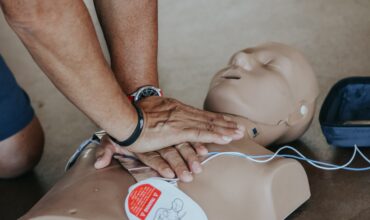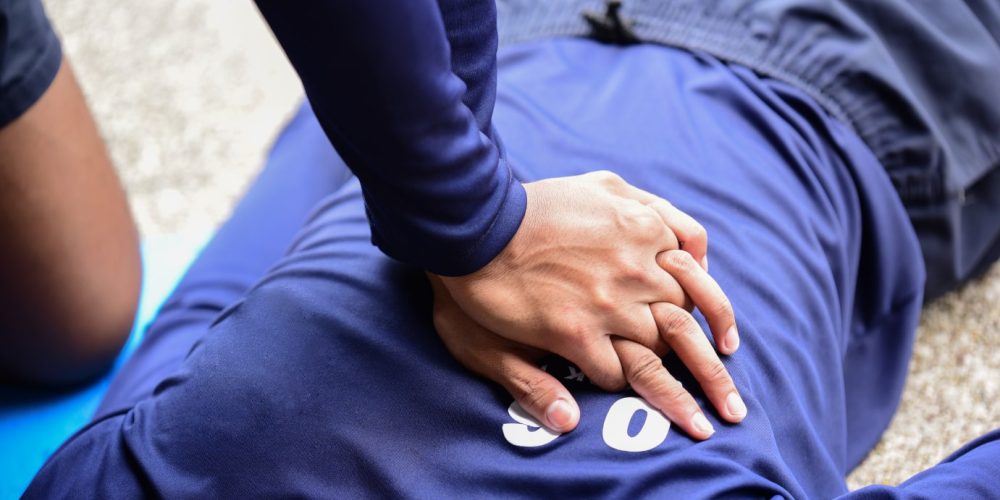- Your cart is empty
- Continue Shopping


In critical situations, such as advanced cardiovascular life support (ACLS), teamwork can mean the difference between life and death. A successful team doesn’t happen by accident—each member must know their role, understand their responsibilities, and communicate effectively. Whether on a sports team, in the workplace, or on an ACLS clinical team, achieving optimal outcomes requires coordination, preparation, and clear communication.
One effective framework for ACLS teams is the Resuscitation Triangle. This model involves six key roles, with three core roles positioned around the patient in a triangle. Let’s explore this model and its importance in life-support scenarios, focusing on how Automated External Defibrillators (AEDs) play a vital role in successful resuscitation efforts.
ACLS stands for Advanced Cardiovascular Life Support. It is a set of clinical guidelines and protocols used by healthcare professionals to manage severe medical emergencies such as cardiac arrest, stroke, and other life-threatening cardiovascular conditions. ACLS involves advanced interventions like airway management, defibrillation, administering medications, and interpreting electrocardiograms (ECGs) to stabilize a patient and improve survival rates.
Resuscitation Triangles are a structured team model used in Advanced Cardiovascular Life Support (ACLS) to ensure efficient and effective response during life-threatening emergencies, such as cardiac arrest. The model centers around three key roles positioned in a triangular formation around the patient.
An ACLS team isn’t merely a group of individuals performing separate tasks. It’s a cohesive unit that:
Anticipates each other’s needs.
Communicates continuously.
Leverages each member’s strengths to enhance overall performance.
Provides constructive feedback to improve outcomes.
The Resuscitation Triangle fosters this dynamic by providing a clear structure for roles and responsibilities. Let’s break down these roles and their functions.
The ACLS team includes six critical roles, divided into two categories:
Compressor
AED Monitor/Defibrillator
Airway Manager
Team Leader
IV/IO Medications Manager
Timer/Recorder
In smaller teams, some members may take on multiple roles, but the core responsibilities of the triangle—compressions, defibrillation, and airway management—must always be prioritized.
The Compressor provides life-saving chest compressions, a cornerstone of effective resuscitation.
Responsibilities:
Assess the patient.
Perform five cycles of compressions.
Alternate with the AED role every two minutes to prevent fatigue.
The AED Monitor is responsible for delivering shocks when needed, a critical function in restoring normal heart rhythms.
Responsibilities:
Operate the AED or defibrillator.
Alternate with the Compressor every two minutes.
Position the monitor for clear visibility by the Team Leader.
This role ensures the patient’s airway remains open and effective.
Responsibilities:
Open the airway using proper techniques.
Provide bag-mask ventilation.
Insert airway adjuncts when appropriate.
Monitor airway placement continuously.
The Team Leader oversees the entire resuscitation effort.
Responsibilities:
Assign roles and delegate tasks.
Make critical treatment decisions.
Provide feedback and guidance.
Step into unfilled roles when necessary.
This role manages intravenous or intraosseous access and medication delivery.
Responsibilities:
Establish IV/IO access.
Administer medications per protocol.
Ensure access remains open and functional.
Accurate documentation and timing are crucial for effective resuscitation and future improvement.
Responsibilities:
Record the timing of interventions and medications.
Track interruptions in compressions.
Communicate timing details to the team.
Successful ACLS teams share several key dynamics:
Team members should understand their own skills and limits. For example, someone inexperienced with IV insertion shouldn’t handle that task during a high-pressure scenario.
When a potential error arises, team members should address it tactfully.
Example:
If the Team Leader suggests an incorrect dosage, a team member might say, “Are you sure about that dosage? I believe it should be X.”
Encourage open communication and question all assumptions to prevent errors, such as fixation on outdated protocols.
The Team Leader should frequently summarize progress and highlight any changes in the patient’s condition.
This ensures clarity in high-stress situations. For example:
Open-ended: “Can someone check the patient’s blood pressure?”
Closed-loop: “Henry, please check the patient’s blood pressure now and report back.”
AEDs are indispensable in cardiac emergencies, especially for non-medical personnel. These devices analyze the heart’s rhythm and deliver shocks to restore a normal heartbeat. Integrating AEDs into the Resuscitation Triangle enhances team effectiveness by providing:
Clear voice prompts to guide rescuers.
Quick rhythm analysis to reduce downtime.
Easy-to-use interfaces for fast action.
At AED Brands, we offer a range of AEDs designed for professional and public use. Whether in hospitals, schools, or workplaces, our devices empower teams to act quickly and confidently during cardiac emergencies.
Understanding the Resuscitation Triangle and its roles is vital for effective ACLS. By ensuring clear communication, knowing each team member’s responsibilities, and leveraging tools like AEDs, teams can significantly improve patient outcomes. At AED Brands, we’re committed to equipping teams with the knowledge and tools they need to save lives.
Explore our range of AEDs and training resources today to prepare your team for any emergency.
The six key roles in an ACLS team are divided into two categories:
Each role has specific responsibilities to ensure a smooth and effective resuscitation process.
AED Brands offers a wide range of AED devices and training resources to ensure your team is equipped for cardiac emergencies. From on-site CPR training to easy-to-use AEDs, we provide everything needed to improve response times and save lives. Visit our website to explore our products and services.
Implementation Guide